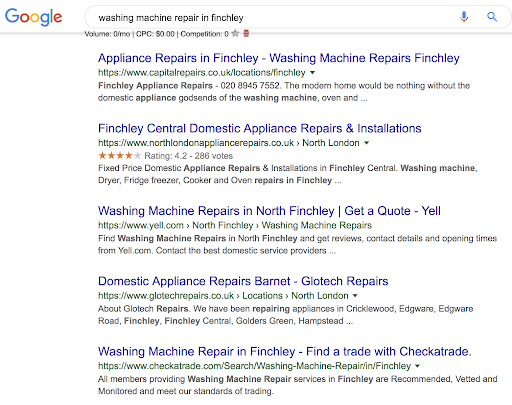UPDATED! One of our most popular posts for the past few years, this ultimate guide to SEO techniques that grow rankings has been updated to get you ready for a successful 2019!
In today’s rapidly shifting world, SEO techniques can change on a dime—and the worst part is, that you might not even know it. Hacks that could have won you a front-page result as recently as 2017 are not only obsolete now, but they may even hurt your website’s rankings. Especially if those so-called “hacks” land your site a Google penalty that’s tough to shift.
That’s why you need to stay on top of the ball in SEO. If not, you’ll fall behind and see your competitors zoom past you in the SERPs.
We spoke with Jacob Warwick, Director of Communications at Skedulo, and Jesse Teske, SEO Manager at YLighting, to get their expert thoughts on the most current SEO tactics, as well as writer and content marketer Puranjay Singh, founder of GrowthSimple.
In this post, we’ve broken down the top SEO techniques to help you skyrocket your rankings and boost your number of monthly visitors from organic search.
But before we dive into the details on improving your web page ranking, let’s take some time to test your current page ranking on search engine results. Head over to Keyword Rank Checker – a tool that you can use to determine your page ranking based on keyword search:
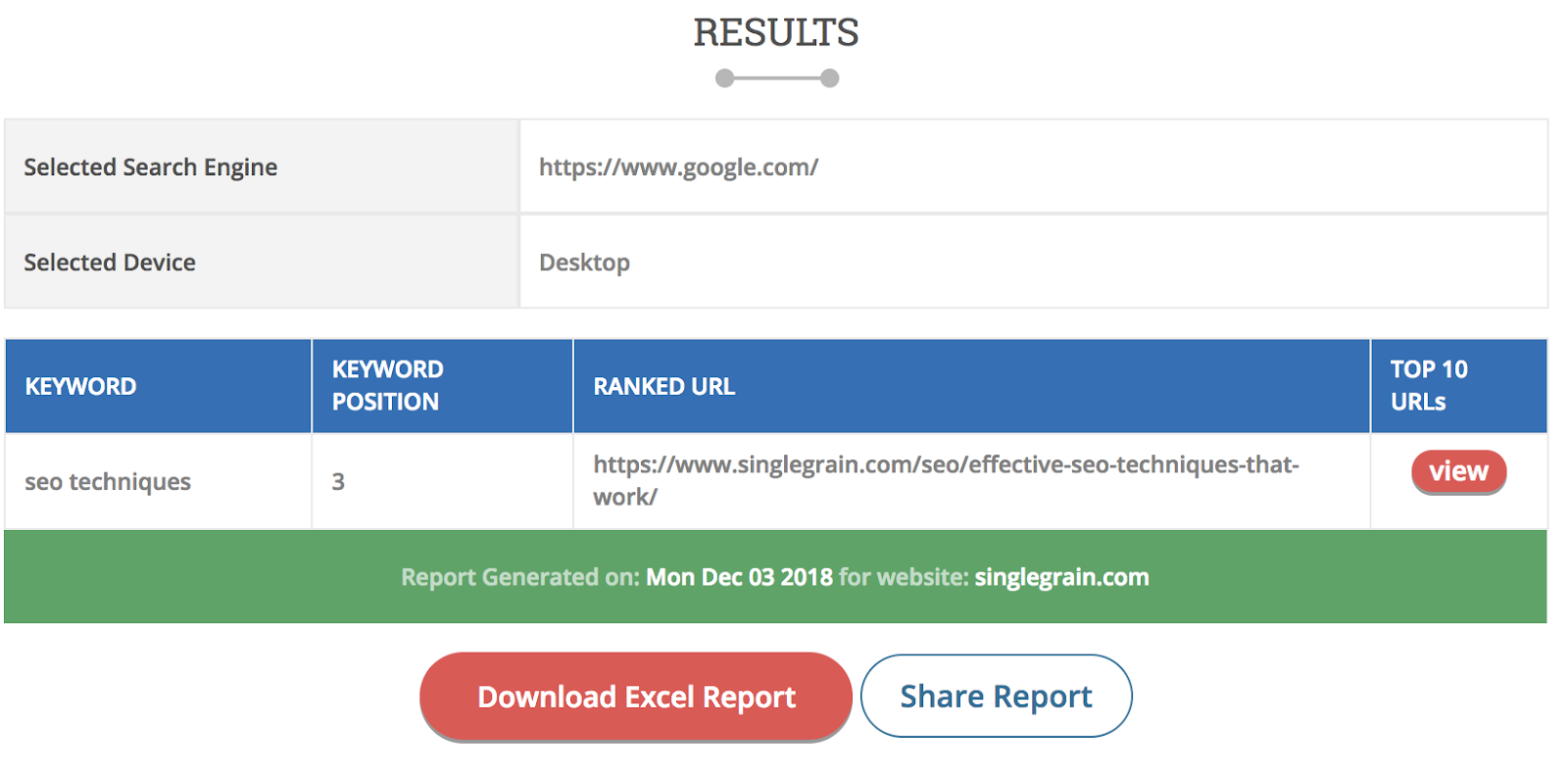
It goes without saying that your goal, as an SEO expert, is make your website reach the top of this list. Higher rankings equals more organic traffic – people you can convert at a later stage, and boost the overall ROI of your SEO strategy.
Sounds like the dream, right? But if you’re feeling disheartened with the keyword ranking check you just ran, don’t panic.
9 Effective SEO Techniques to Drive Organic Traffic in 2019
I’ll talk about these SEO tactics in this post:
- Improve user experience across your entire site
- Optimize for voice search
- Focus on topic clusters instead of keywords
- Go into detail – but only when it’s relevant
- Conquer video with YouTube SEO
- Build a variety of backlinks
- Get a grip over technical optimization
- Target local searchers with local landing pages and listings
- Know how to measure SEO performance
Ready? Let’s dig in!
Further Reading:
1) Improve User Experience Across Your Entire Website
Let’s kick things off with a brief explanation of what Google is here to do. Just like any search engine, they want to show the best results for a user’s query, and if they’re greeting users with a list of irrelevant, low-quality results, they won’t use them again. By the way, Google does this very well, which is why they’re the largest search engine in the world – by far.
You’ll need to think about that constant desire to show the best results when you’re optimizing your website for SEO. Why? The answer is simple: If your site isn’t high-quality enough, you’ll have a tough job ranking for your target keywords.
Nobody wants to land on a spammy website that takes years to load, right? That’s bound to lead to a high bounce rate. And although Google hasn’t officially declared it, there is evidence to suggest that the search engine giant does reward sites that have low bounce rates with higher page ranking:
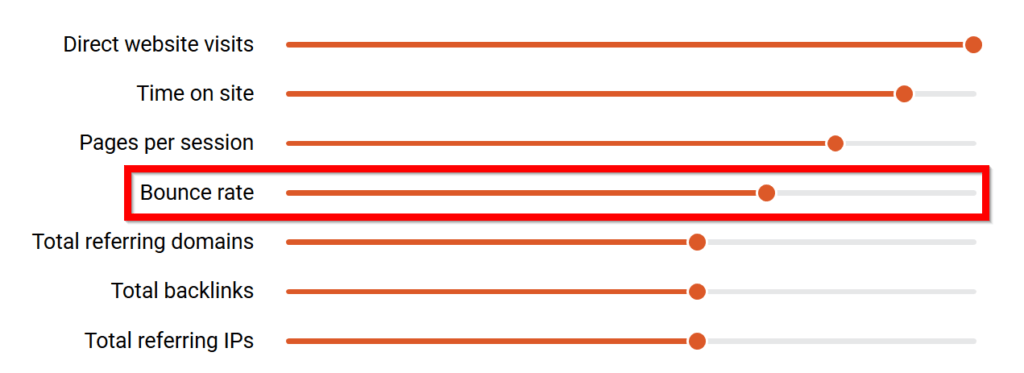
Google’s reasoning is that if a user spends more time on a page, it’s probably because she found the page useful. And since Google only wants to deliver the best possible results to its users, it will push sites with strong engagement up in the search engine results pages (SERPs).
So how can you improve the experience that visitors are having with your website? Unfortunately, reducing your overall bounce rate isn’t as simple as removing a few annoying pop-up ads.
Here are five SEO techniques you can use to improve user experience and give your existing content a boost in search engines:
A) Make Your Posts Easy to Read
Ever heard the phrase “formatting content for the web”? To stand any chance at increasing your organic rankings, we need to take that a step further and optimize your content for readability.
Remember: More people reading your content = lower bounce rate = higher organic rankings.
But how do you format your posts for readability? The following formatting tips can help increase the readability of your content:
- Shorter paragraphs: Generally speaking, limit each paragraph to 3-4 sentences. It’s even okay to use one-sentence paragraphs if necessary, but use them sparingly or your post will look like a bullet-pointed blog without the bullets. A paragraph is a group of related sentences that support one main idea, so if you split up one paragraph into individual lines, your idea tends to be fragmented and makes it hard to grasp the overall point.
- Mixed sentence lengths: Longer sentences are hard to follow on a computer or phone screen, but they can work well when used sparingly, particularly when mixed with medium and short sentences. Here’s a fantastic example of how sentence structures can be varied for readability:
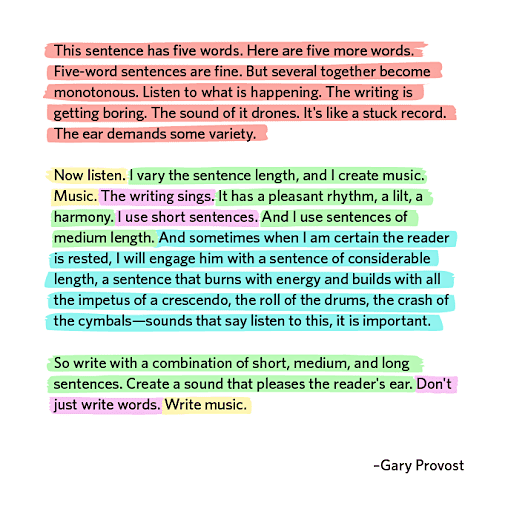
- Sub-headers: Did you know that the average person spends just 37 seconds reading a piece of online content? You can boost that time significantly by including subheadings to make scanning the article easier. Use plenty of clear and informative sub-headers to guide readers down a page, along with call-out points that are emphasized in bold. Readers should be able to scan your blog post and get the gist of what you’re talking about.
- Bullet points: When you have a lot of data—stats, facts, ideas, examples—packed into one paragraph, it makes it easier to read when you list them with bullet points (like this!).
- White space and images: When you visit a web page and are greeted with a huge wall of text, it can feel overwhelming. Prevent your site visitors from overwhelm by breaking up large chunks of text with relevant, supporting media, including photos, videos and graphs (in addition to bullet points and sub-headers).
- Write quality content: All these other points are meaningless if your writing is just bad. Good writing is not necessarily about paragraph or sentence length, bullet points, headers and images; good writing is about great ideas and compelling delivery.
B) Use Bucket Brigades to Pique Interest
Originally, a “bucket brigade” was a chain of people who pass buckets of water from person to person to extinguish a fire. Now it’s a copywriting technique designed to capture a reader’s interest and then keep them reading the rest of your page (reducing bounce rate), much like the flow of the bucket being passed down the line.
It essentially involves breaking an idea into multiple sentences, using a trigger word or phrase, and then ending the sentence with a colon to pique interest. Look at this example from Copyhackers:

Fancy putting this into practice? Here are a handful of bucket brigades you can sprinkle throughout your content:
- You might be wondering:
- The answer is:
- You’re probably thinking:
- Here’s the deal:
- It gets better:
C) Write in the Inverted Pyramid Style
If you went to journalism school, you know all about the inverted pyramid style of writing:

This method means giving away the most valuable information at the top of the article, and following it up with less important information. If readers tend to scan and rarely make it to the bottom of an article, it makes sense to give them what they want as soon as they land on the page.
D) Analyze (and Improve) Current Page Designs
More often than not, high bounce rates result from poor usability and an awkward user experience (UX). However, it’s tough to figure out where pesky UX problems are an issue because they can vary dramatically from site to site.
Here are five user-testing tools you can use to analyze how people are interacting with your website – and spark ideas for improvement:
Clever and intuitive, Crazy Egg helps subscribers rate and understand user experience with their rich visual aids like heatmaps, scrollmaps, confetti, and overlays. Each of these are graphic representations of one aspect of UX.
For instance: Heat maps are colorful representations of where users have clicked on your site, while scrollmaps show you just how far down the page your users scroll before leaving.
With this data, it’s possible to figure out what your best design features (or flaws) are, and correct them accordingly. On Crazy Egg’s home page, they’ve included an example of a heatmap of their own site which shows where their visitors clicked:

Optimizely, the world’s leading experimentation platform, specializes in A/B testing—a scientific, data-driven way to test websites for maximum usability and engagement. In A/B testing, multiple versions of a web page are randomly shown to users, compared against a control page (generally the existing website), and then analyzed for effect.
The biggest advantage of a proper A/B testing process is that marketers can understand how even the tiniest changes can positively affect their website, such as:
- Moving the “buy” button to the left
- Changing button colors from red to blue
- Switching headline text from “download now” to “get your free e-book”
Many A/B tests can have surprising results. For example, Michael Aagaard from ContentVerve found that moving the CTA to the bottom of the page actually increased conversions by 304%, compared to placing the CTA above the fold (which goes against most SEO best practices):

The genius of Optimizely is that it massively simplifies something that would otherwise require a team of dedicated, experienced UX designers and researchers to carry out.
Along the same lines, Optimize by Google Analytics also assists marketers improve and maximize customer engagement and conversion. As a free version of its Optimize 360 program, Google’s Optimize is a streamlined, user-friendly software that simplifies A/B testing and includes advanced modeling to improve engagement and targeted experiences.
But perhaps the biggest draw of Optimize is that it seamlessly integrates with Google Analytics, allowing marketers to further leverage their existing resources. With Optimize, marketers can use existing Analytics metrics as a starting point, which allows them to rely on a familiar interface as they move on to deeper and more complicated experiments.
Here’s a shot of the Google Optimize user screen. Notice that it gives recommendations and suggestions for the optimal interface:
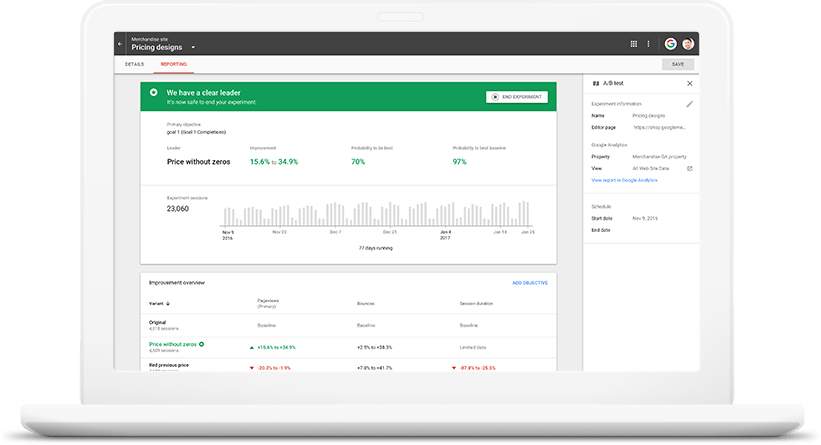
While Google Optimize and Optimizely are essentially DIY UX tools for marketers and small business owners, User Testing is far more specialized.
They say users can “capture the critical human insights you need to confidently deliver what customers want and expect”. And, in its most basic form, User Testing is more of a pure research tool—gathering commentary from target audiences and offering marketers detailed videos of user interaction and behavior.
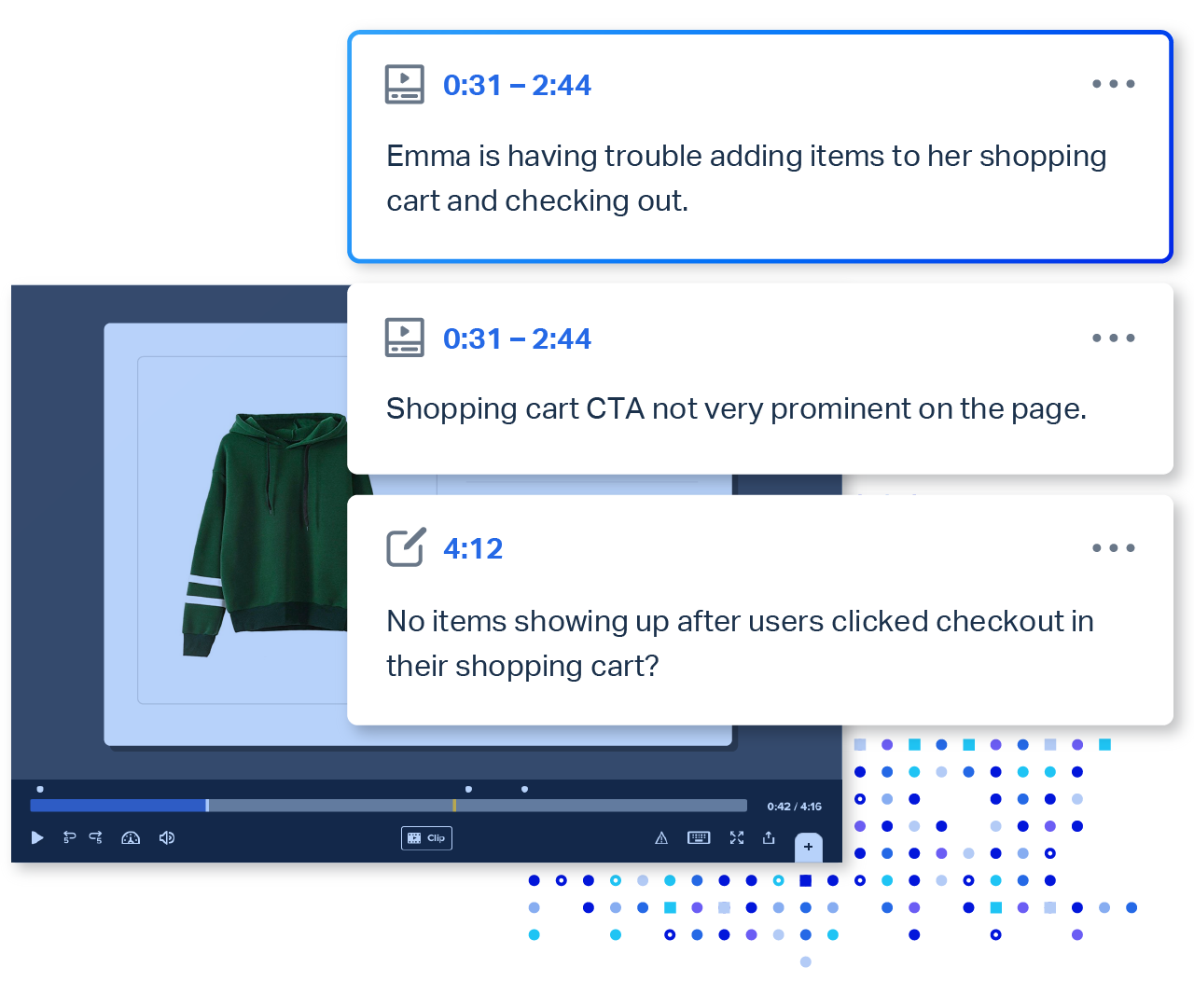
The above four tools are some of the best UX testing programs available today. Yet one of the best UX resources isn’t digital, but rather a book: Don’t Make Me Think, a groundbreaking work by UX designer Steve Krug that has sold 100,000 copies over five years.
With its conversational tone and engaging manner, Krug’s work gets readers into the habit of critically examining and rethinking everything about their websites, including even the tiniest details, like misplaced buttons or unwieldy site maps.

ClickFlow is a tool we built to help companies increase organic traffic without more backlinks or posting more content.
Through ClickFlow, companies can automatically see which pages on their site have the most potential to grow revenues, such as pages that have high impression count in search but a low click through rate. Using that information, ClickFlow will keep track of headline tests to help grow your click-throughs from search terms you already rank for.
The tool drives up your bottom line by showing you how much revenue you’ve gained and how much you stand to gain. It’s been used by companies like LeadPages, Drip, The Atlantic, and more.
SEO Experimentation Tool – ClickFlow
E) Site Speed
Back in 2010, Google announced that it would be using site speed as a ranking factor. Fast forward almost a decade and now Google has consistently emphasized the importance of site speed:

Site speed plays a huge role in SEO because people don’t want to wait years to access information they’re searching for.
That’s why Google has launched a number of SEO tools to help improve site speed, including:
Clearly, Google wants your website to load faster than it is right now. But how fast?
Maile Oyhe, former Developer Programs Tech Lead at Google, said:

You should improve your site’s speed not only to work your way up Google’s rankings, but also to increase conversions. One survey found that nearly 79% of web shoppers who have trouble with website performance won’t return to the site to buy again – which could see you losing out on a ton of conversion-rich search traffic who are ready to hand over their hard-earned cash for your product or service.
So, how can you boost page speed to impress Google, secure higher rankings, and close more conversions? Here’s your answer:
- Minify unnecessary code on your page
- Reduce server response timings
- Enable browser caching
- Compress images to cut down page size by 30-40% using a tool like Kraken:
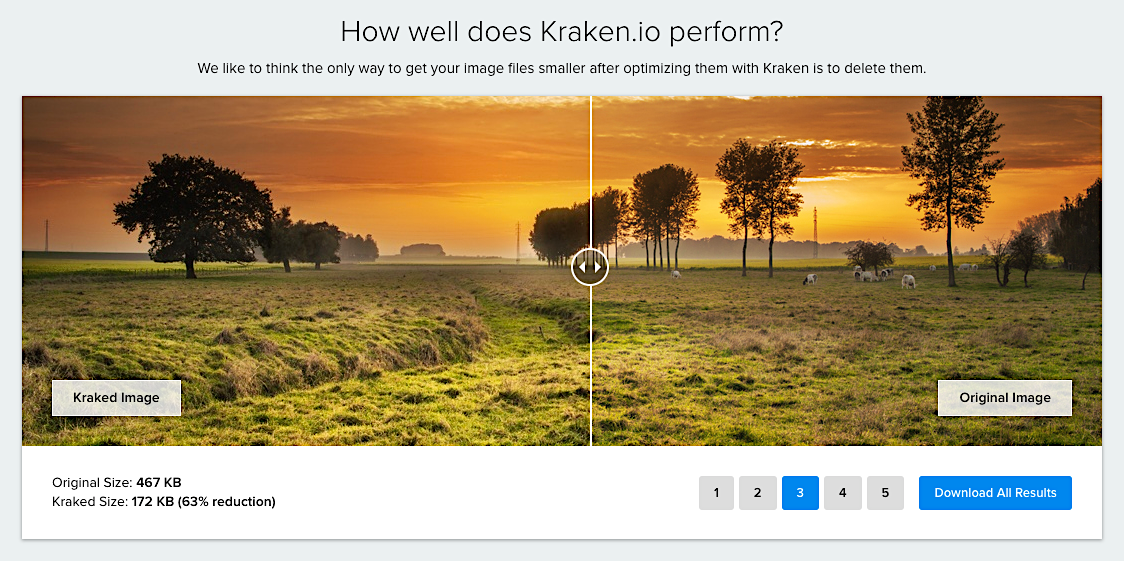
Further Reading:
2) Optimize for Voice Search
Did you know that 50% of all searches will be conducted by voice by next year?
That’s right: Half of all the people heading to Google aren’t typing their queries – they’re using a voice-assisted device to do the job for them.
If you think that’s not something you’ll need to factor into your SEO strategy, you’re wrong. Voice searchers have different habits than text searchers, and the devices they’re using (whether that’s an Amazon Alexa, Siri or Google Home) take data from SERPs to replay information from the featured snippet box back as their answer.
For example, a text searcher might type “shark diet.” A voice-based search, however, is likely to be more longer tail, like “what do sharks eat?”:
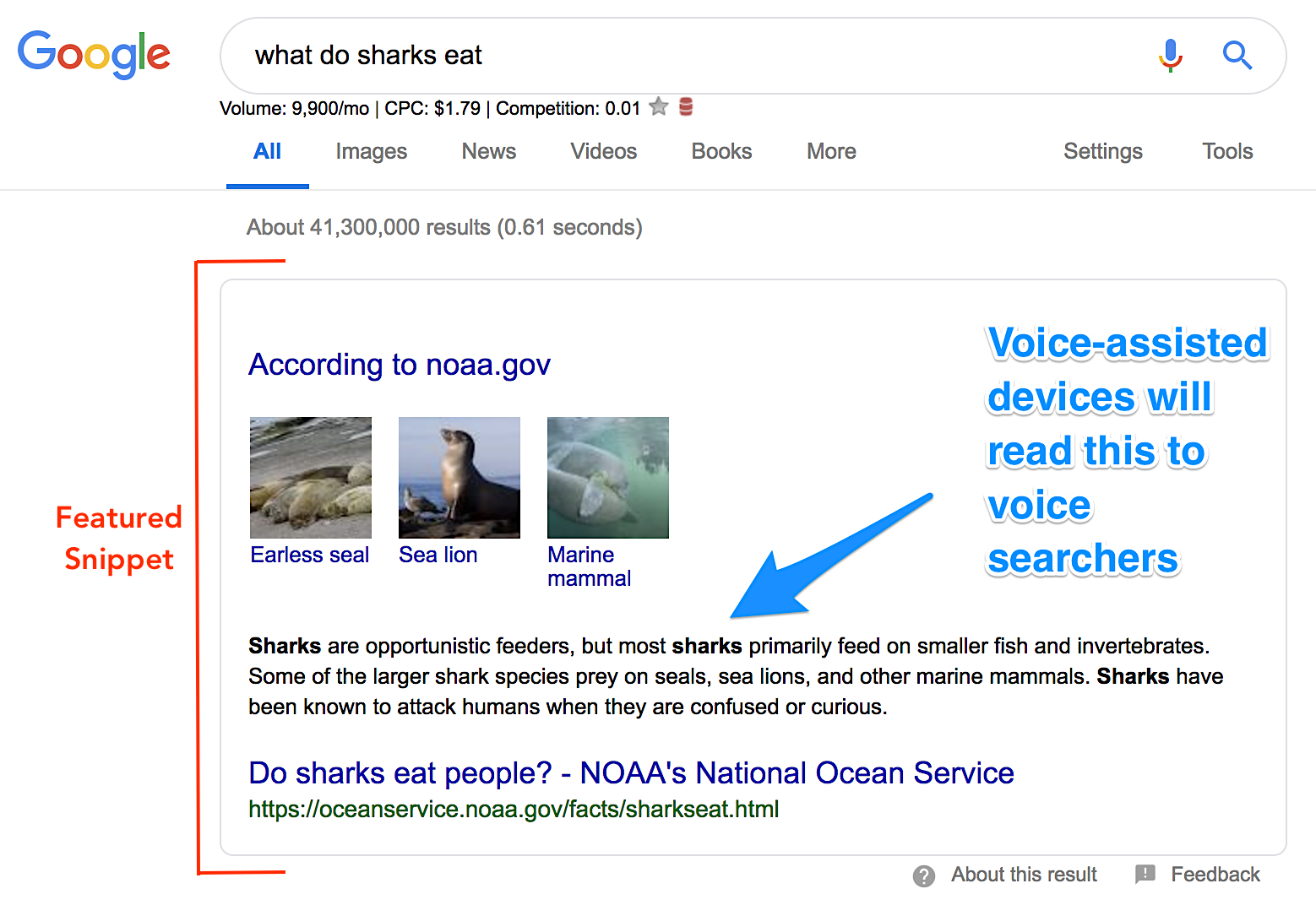
There’s one key difference with the two: Voice searches tend to be question-based:

That’s why our second SEO technique is to optimize your website to answer questions – if you want to target the one in six Americans who own a smart speaker. But how do you do that without overhauling your entire website. Here’s the answer:
A) Write Content Around Long-Tail Keywords
Moz found that voice searchers use long-tail keywords when they’re searching for information through Google, and these terms are 3+ words in length:
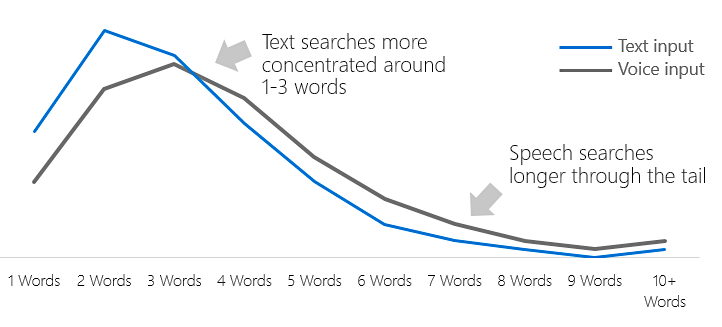
To stand any chance at ranking for those longer keywords, you’ll need to create content that targets them on your website using this process:
- Identify one long-tail keyword using this guide (e.g. “how to wash a car”).
- Find 2-5 other, relevant long-tail keywords (e.g. “car washing guide” and “tips for washing a car”).
- Write a long-form, comprehensive blog post that’s 10x better than anything else already ranking for those long-tail keywords. Remember to format the content for readability.
- Promote your content like crazy.
- Build backlinks to your blog post (more on that later!).
- Watch your content start to rank.
B) Use Structured Data
Remember how we said that Google takes information from the featured snippet box and replays that back to voice searchers? Using structured data is a fantastic way to boost the chances of your information being read aloud to your target audience.
There are several types of structured data (also known as Schema markup) that SEOs can use, both of which give Google a quick rundown of what your page is about. That, in turn, helps it to rank better.
Get started by heading over to Google’s Structured Data Testing Tool to find out whether you’ve already got Schema implemented:
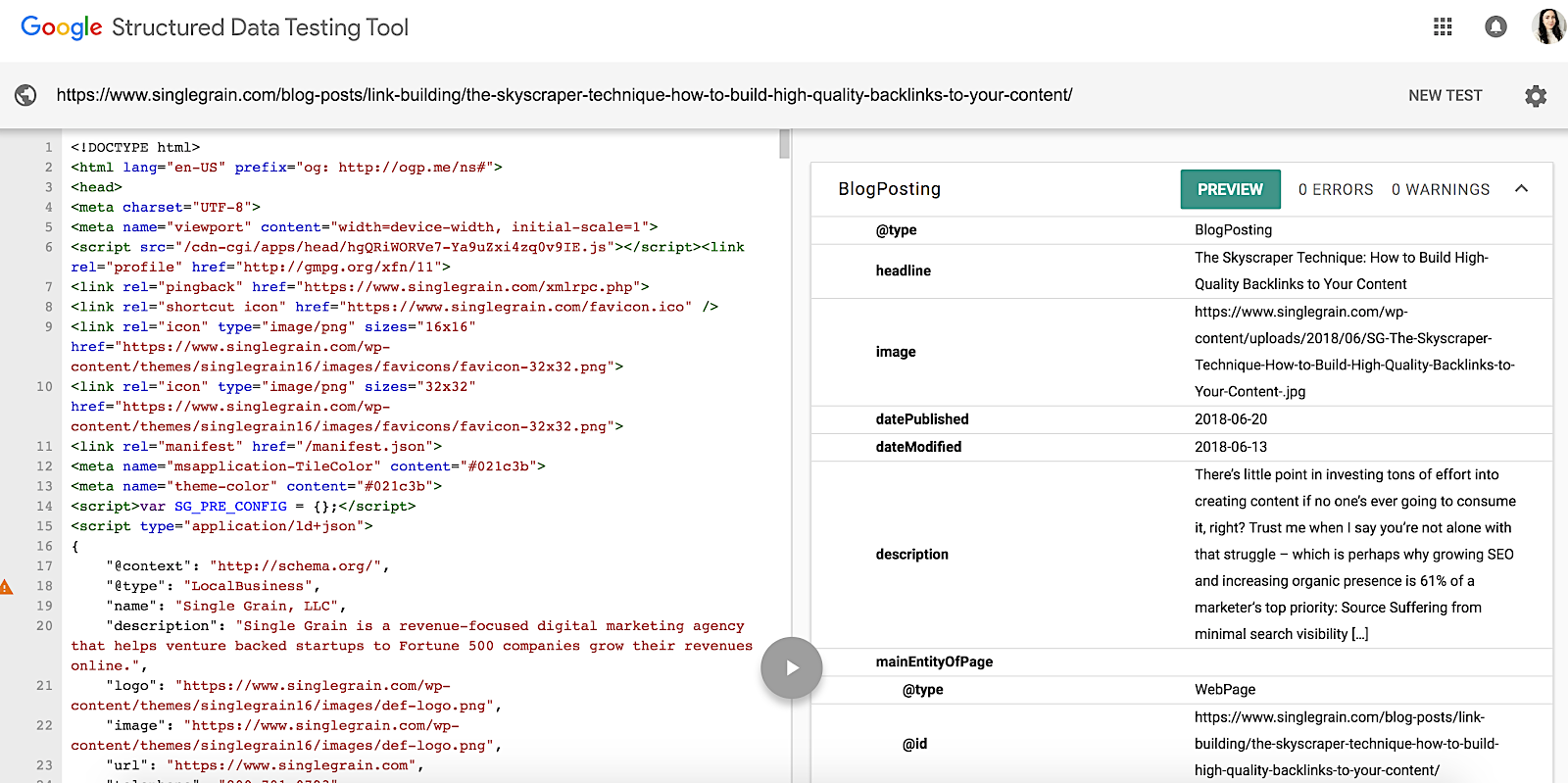
If you don’t, don’t panic! Here’s Google’s guide to Schema markup that explains the type of code you need, and how to implement it.
3) Focus on Topic Clusters Instead of Keywords

Google is evolving – and so is its algorithm. Its objective now is to understand the intention of its users: what they expect, what they’re looking for and, more specifically, what search results would best help answer their query.
That’s where the featured snippet box comes into play…again:

But don’t expect your website to end up on the first page of Google simply by creating keyword-focused content. It’s not enough to look at keywords alone. We need to look at the context around them.
Also referred to as “user intent,” you must consider what your users are looking for, rather than coming up with different ways that users can phrase a search query
Here are two things in particular you should consider:
A) Know Your Target Audience
The type of content you’ll create will depend entirely on your audience. The better you know them — their location, age, interests, etc. — the better the content you’ll create (and the better your SEO).
For example, suppose your keyword tool shows that “Android” has a search volume of 2,740,000 per month. That’s a lot of people you could be exposed to, so you’ll need to target it heavily, right? Not necessarily. People searching for it could fall into several categories:
- Mobile users searching for Android help
- Star Wars fans looking for droids
- Robotics enthusiasts looking for information about Androids
Without knowing your target audience, you might end up creating content for all these topics. That won’t win you readers or good rankings because you can’t please all three with a single piece of content optimized for such a broad term.
However, by building buyer personas that detail the shared traits of your ideal customers, you’ll be better able to zero in on topics that matter to your readers, while also minimizing the chances of creating content that doesn’t actually get results.
B) Organize Content into Clusters
Instead of focusing on standalone keywords, organize all your content into different themes. The topic cluster model, created by HubSpot, works by breaking down your content calendar into topic and clusters, with the:
- Pillar page – being a large, 2,000+ word resource that gives a broad, overarching view on one topic
- Clusters – being smaller pages, linked-to from the pillar page, which explain certain sections in greater detail
Here’s the topic cluster model put into practice:
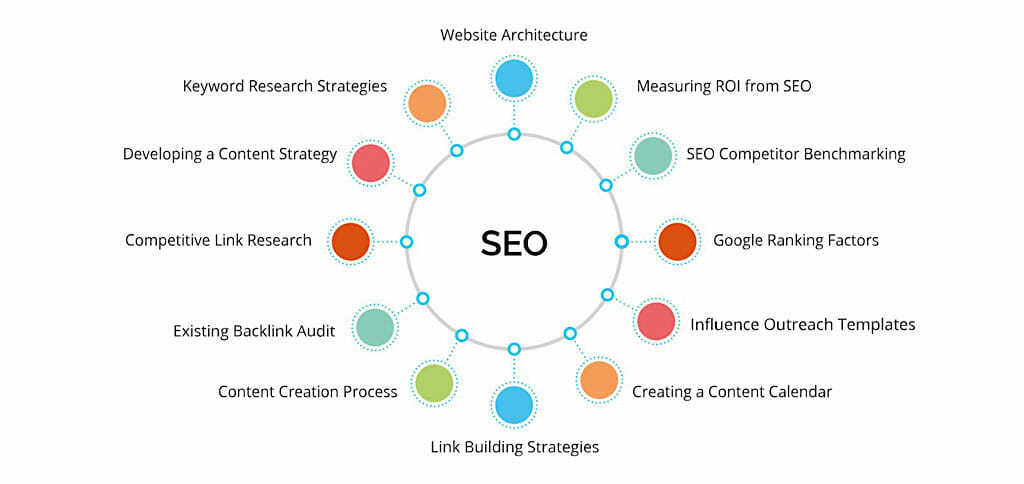
Using that content strategy satisfies user intent since they’re getting information they’re searching for, while also creating a library of internally linked content that Google’s spiders will crawl, understand and use to rank each page.
C) Research Keywords—and Use Them Sparingly
Confused why we’re listing keyword research as an SEO technique when we’ve told you to focus on topic clusters, rather than keywords? Because keywords still matter.
Organizing content thematically is very important, but it’s a mistake to ignore keywords entirely, given that they serve as signposts to Google’s spiders, signaling topics and giving hints as to the nature of the content on the website.
Marketers now face a struggle to find accurate search volume data with Google Ads hiding those results (unless you run a PPC campaign). However, there are a number of tricks and tools that can help marketers find topics and volume data, including:
A one-stop shop from the SEO specialists at Moz, Keyword Explorer is a versatile, dynamic program that covers nearly every aspect of the keyword process. With this tool, marketers can brainstorm keywords, build lists and filter them by topic. You can also analyze metrics, click-through rates and other measures of effectiveness, as well as spy on and assess keywords used by your business rivals.
Another great tool for SEO analysis, particularly where it concerns business intelligence, SEMrush allows you to identify and analyze the keywords that your competitors are using. Enter your competitor’s URL into the SEMrush search bar and you’ll be provided with a list of SEO keywords, along with their rankings and traffic.
For instance, a search on “title boxing“, one of the most popular online boxing and kickboxing retailers, yields 90,500 organic searches for the term “punching bag” (fourth overall), as well as 60,500 results for “title boxing,” the name of both their in-house brand and retail store.
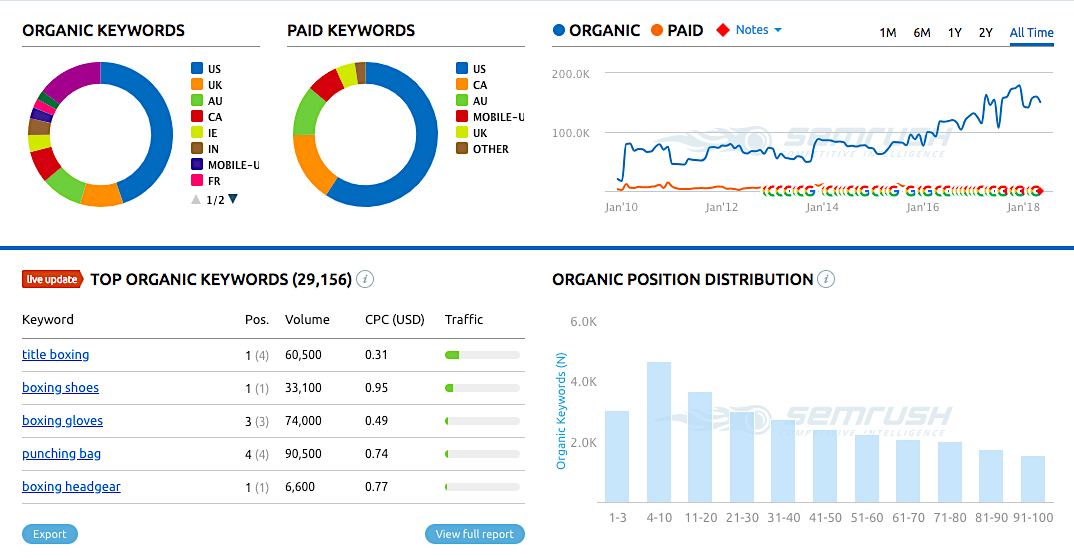
Interestingly, SEMrush also allows users to use a competitive positioning map, where they can see overall website traffic and keywords: title boxing boasts 150K+ in search traffic and 29K in keywords, far outpacing their closest competitors.
Ahrefs offers a wide range of products, including backlink checkers, content explorers and position trackers. For our purposes, however, we will focus on their expansive, adaptable Keywords Explorer, which allows marketers to search nearly 3 trillion keywords in over 170 countries, assessing metrics like keyword difficulty, click-through rates, related keyword lists and search volume.
When considering which keyword tools to use, look for something that allows you to monitor a high volume of keywords broken down by relevant themes. Additionally, the best tools must ensure that you can track all your competitors, from large corporations to small, up-and-coming firms.
As always, go for quality and not quantity.
It’s always better to get 10 conversions from 100 visitors (10% conversion rate) than it is to get 10 conversions from 1,000 visitors (1% conversion rate). Click To Tweet
Rather than casting a too-wide net, focus on keywords and topics that are within your niche, ones that you can optimize for and be the authority on. Fill in these gaps and establish yourself as an expert in this smaller field before tackling larger and broader keywords where the competition is much fiercer.
As for keyword ideas themselves, Google offers an easy (and cheap!) way to discover related search ideas. Just type “sushi restaurants in San Francisco” into the search bar of Google Chrome and you’ll be presented with related images along the middle of the page, such as the names of specific restaurants, times they’re open, and where they’re located.
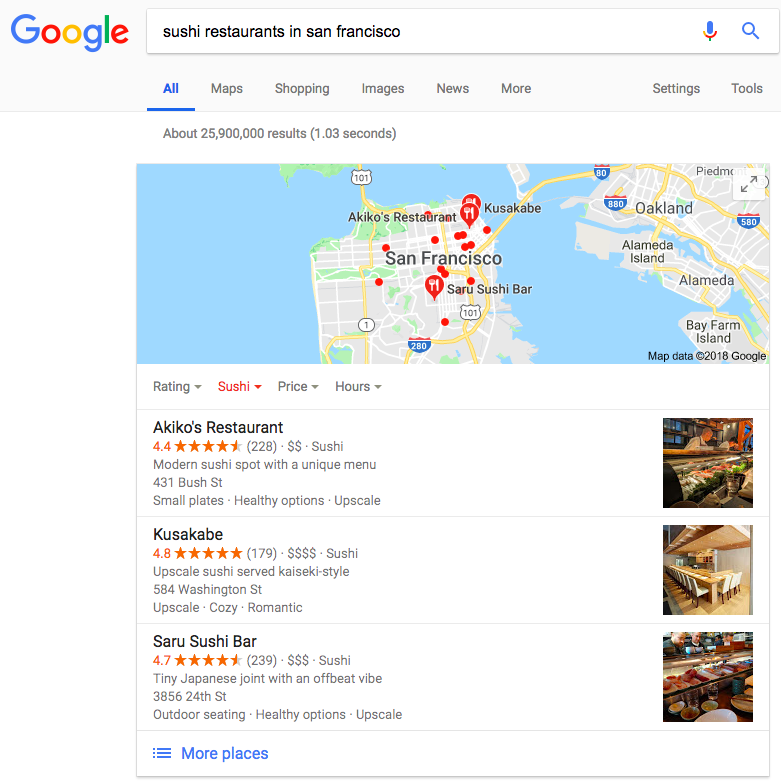
This is a strong hint for developers to include these topics in their content, or to create pages to leverage these related images.
Further Reading:
4) Longer Content Equals Higher Ranking—Usually
A recent study by Backlinko concluded that the longer the content, the higher the likelihood of its ranking at the top of the SERPs:

However, writing 2,000+ words for every blog post is not for everyone. It’s an intensive and time-consuming process – but most of all, sometimes it’s not necessary. Remember what we said about satisfying user intent?
Some search queries are by people who aren’t looking to digest a lengthy blog post. Their answer could be a matter of words or a few paragraphs, so the other 1,500+ words you’re pressuring yourself to create might be a total waste of time and energy.
Let’s take the “link building tips” keyword, for example. People searching for that phrase are likely looking for a comprehensive guide to link-building strategies they can use to conquer Google.
People searching for “link building do’s and don’ts”, on the other hand, might not need that lengthy type of content. A simple bullet-pointed list is probably all they’re looking for.
Unfortunately, there’s no hack to determine how long your content should be other than good old-fashioned common sense. Ask yourself what information someone would be looking for if they’re using a keyword you’re targeting, and start from there.
Concluded that 2,000+ words are necessary? Here’s how you can create long-form content (without the stress):
A) Build and Repurpose What You’ve Already Got
Struggling to find the motivation to write a long-form blog post? Instead of starting from nothing, take an existing page from 1,200 words to 2,000, rather than going from 0 words to 2,000 words.
Existing content already has authority and an established readership. So rather than writing something entirely from scratch, it’s much simpler to find a post of yours that is already doing well on Google, refresh it with updated information and extra content, and rely on existing signals to make it rank for terms.
Here’s how you do it:
Under “Search Traffic” in Google Search Console, click on “Search Analytics”:
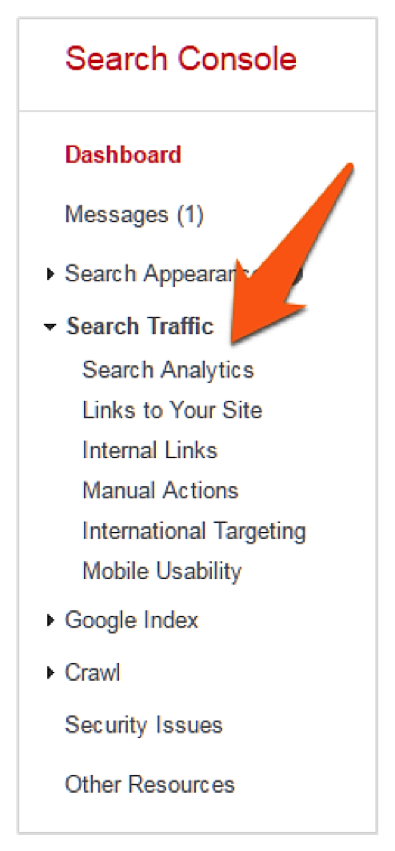
On this page, check “Position” and select “Pages”:

Try to find pages that are ranking between positions 11-30 on Google. These are ideal candidates for additional content that can increase their rankings. It’s your job to re-optimize the page, add more relevant keywords, and offer more information to searchers.
5) Conquer Video with YouTube SEO
YouTube videos rank in the top 10 of Google search far more often than any other type of video. And, according to Forbes, YouTube is also the second most popular search engine with more than 3 billion searches per month – surpassing Bing, Yahoo, and AOL combined.
Most SEOers forget about YouTube when they think of search engines. But if you’re smart, have a knack for creating engaging videos, and have the time to invest into optimizing each video for YouTube SEO, there’s no reason you can’t build a huge audience on that platform. One YouTuber doubled their traffic with the same content after implementing YouTube SEO.
Learn More: The Complete Guide to YouTube SEO
Here’s how you can get in on the action (after creating your video, of course):
A) Make Your Video SEO-Friendly
Just like Google’s spiders, YouTube’s algorithm works by understanding information about your video. The filename, the title, the description of your uploaded content — all these elements affect your rankings in YouTube search.
- Video Title – Crafting a compelling video title is a balancing act — you have to make the title SEO friendly and make it clickable to improve your click-through rate. Ideally, you should follow the same convention in your video titles as you would in your blog posts; to get clicks and shares, include keywords as well as power words. Here’s a great example of a killer title:
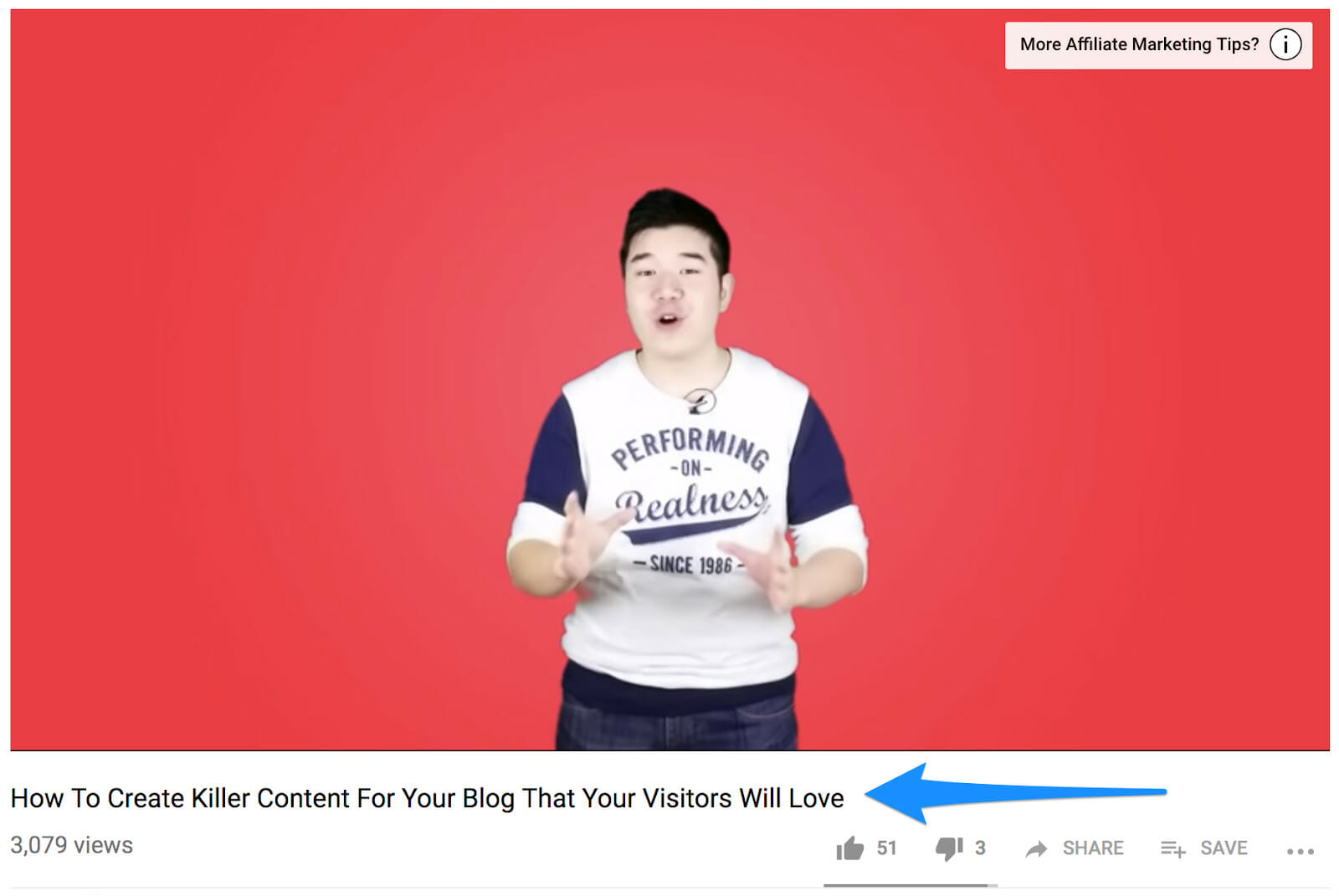
Another tactic is to use your keywords at the start of the title, then add a sub-header after a colon to drive clicks. Here’s an example:
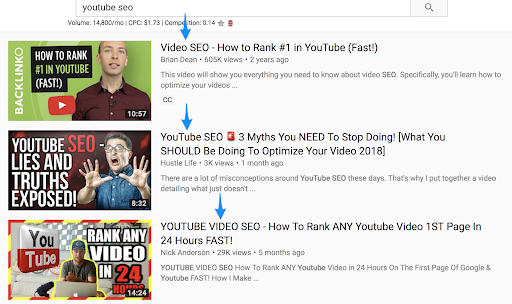
At the very least, your title should have 5+ words and include a broad target keyword. This will not only help you rank in SERPs but also get you more clicks on YouTube.
- Video Description – Because YouTube’s spiders can’t “read” videos, they will rely on your written description to determine what your video is actually about. But instead of just throwing in some target keywords, try creating short blog posts that describe your video content in detail. It can be as short as this example from Growth Everywhere:
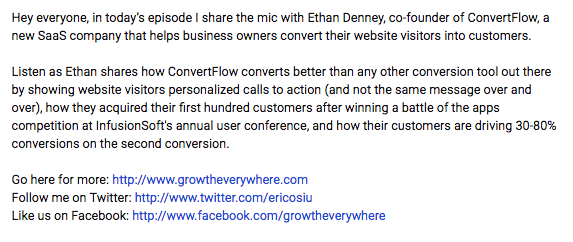
Or as long as this example from James Stafford:
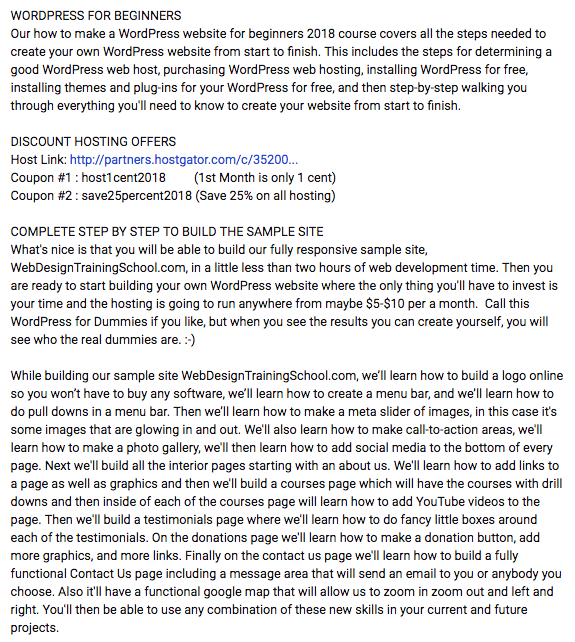
This tells Google — as well as your readers — exactly what your video is about. Since most of your competitors aren’t doing it, it will also help you rank way faster.
Bonus: Use a video transcription service to turn your YouTube video description into a script of your entire video. That way, YouTube has tons of information to work from when deciding where your content should rank!
B) Make Longer Videos
Like content, longer videos tend to do better in YouTube search.
Try it yourself. Type in a popular keyword or topic and see what shows up at the top of the page. For example, here’s what you’ll see when you type in “WordPress”:
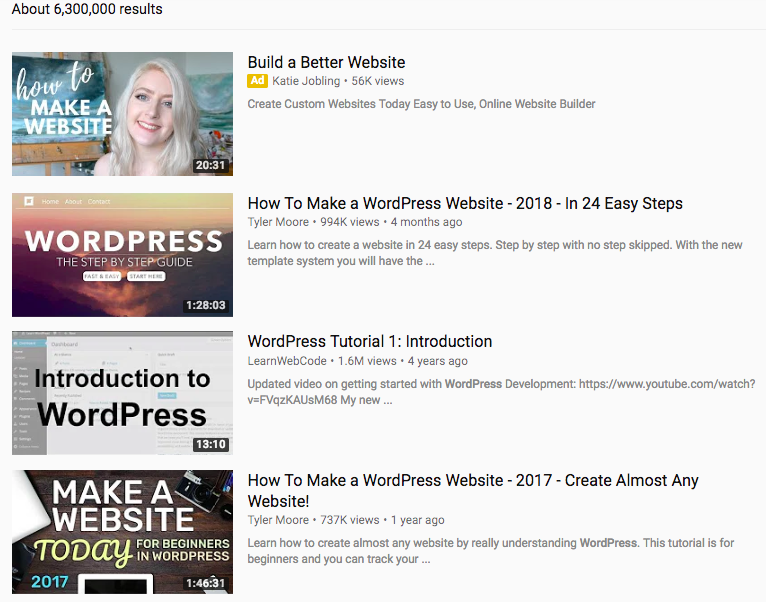
Or when you search for “photography tips”:
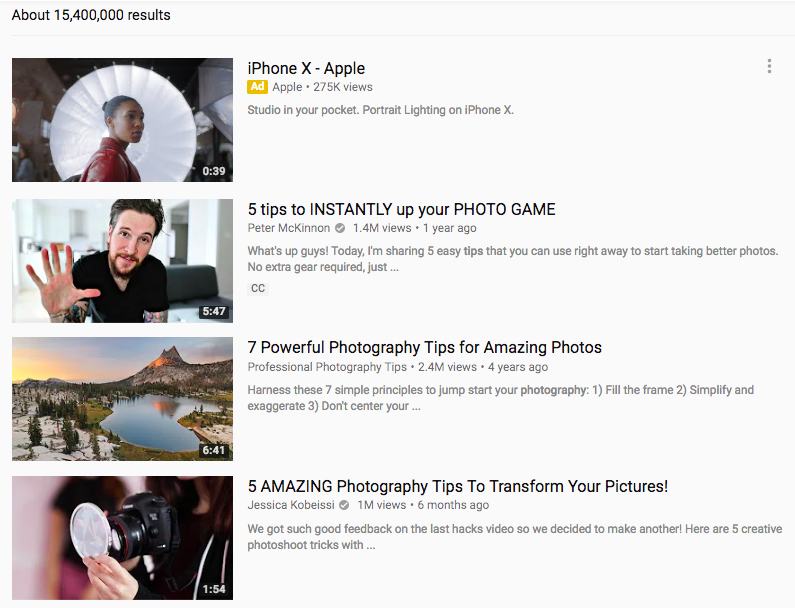
Notice how all these videos are 5+ minutes long? As with written content, longer videos tend to get the most traction – but remember to think about user intent first.
C) Create Custom Thumbnails
The majority of search engines use click-through rate as a ranking factor. If people are clicking through to your result when they’re searching for a specific term, you must be offering something of value, right?
Optimizing your video with a great thumbnail can help that.
A strong thumbnail should tell viewers exactly what the video is about. Ditch one of YouTube’s screenshots of your video and create a custom thumbnail that uses a compelling image along with a title card.
Here’s an example for the term “how to write a blog”:
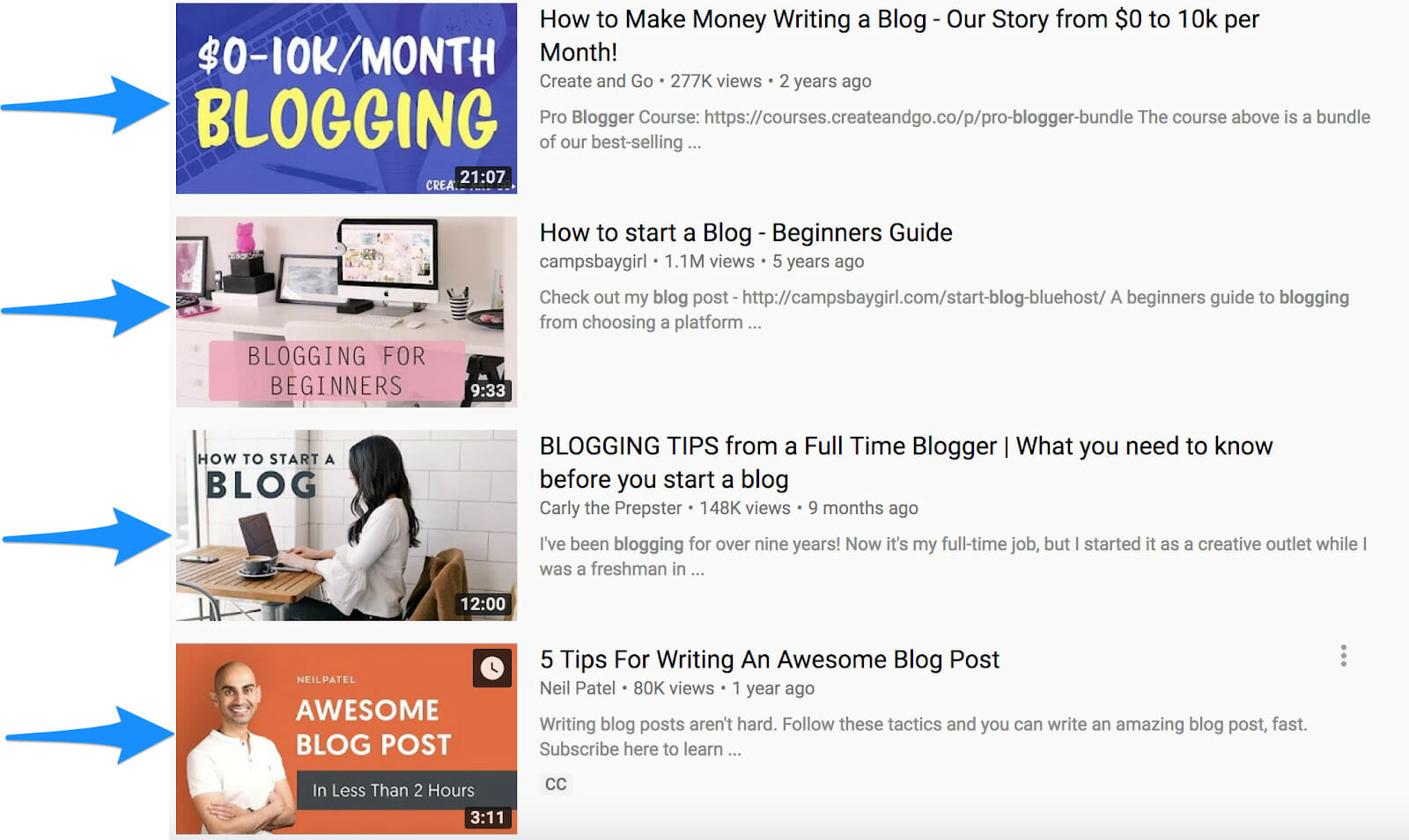
6) Build a Variety of Backlinks
It won’t come as a surprise to learn that backlinks are important in the SEO world.
According to Google, links are still the #1 factor when it comes to determining search rank because without them “ranking without links is really, really hard.” Additionally:

However, don’t fall into the trap of thinking “any link is a good link.” Low-quality links that are easily spammed — blog comments, paid links, etc. — don’t seem to work anymore and can actively harm your site.
Links that are earned — through high-quality content, outreach and influencer marketing — on the other hand, are safe and extremely effective.

What has changed is the way you must build backlinks if you want good results. Low-quality links that are easily spammed—blog comments, paid links, etc.—don’t seem to work anymore and can actively harm your site.
Links that are earned—through high-quality content, outreach and influencer marketing—on the other hand, are safe and extremely effective.
But Google likes to make things tricky for us. If your entire backlink profile is full to the brim with extremely high-quality links (from sites like Entrepreneur and Forbes), there’s a chance that your website will be flagged for a manual review. If you don’t pass that because your site looks too squeaky clean, you might land a Google penalty.
The best way to prevent that from happening is to diversify your backlink profile. For every incredible link you build, create another five that are medium quality. You’ll end up with a variety of links pointing to your website, including links from:
- Blogs
- Author bio sections
- Product pages
- News sites
- Forums
- Directories
That’ll get Google off your back, make your entire site look more natural, and less like you’ve hired an SEO spammer to build your rankings.
Further Reading:
7) Get a Grip on Technical Optimization
SEO and content tips aside, it’s absolutely essential to have a solid website, without worrying about any technical issues that may arise. Why would Google rank your site in position #1 if users are greeted with a ton of glitches?(Hint: It wouldn’t.)
You’ll need to get a grip on your technical SEO in order to rank well in 2019 and beyond using these tips:
A) Switch to HTTPS
Ever visited a website and been greeted with an ugly error page like this?
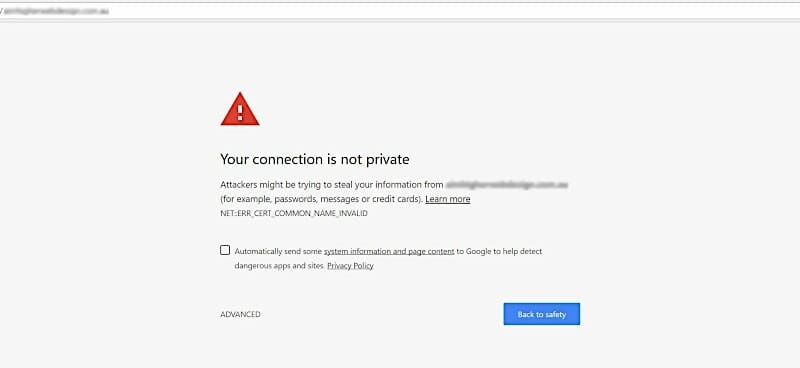
It happens when sites don’t have HTTPS – the most commonly used, securest version of the old HTTP web protocol.
Google has started to warn users when they’re visiting non-HTTPS websites, and if you’re yet to make the switch to secure, encrypted connections, you might be turning away a huge chunk of people willing to visit your site.
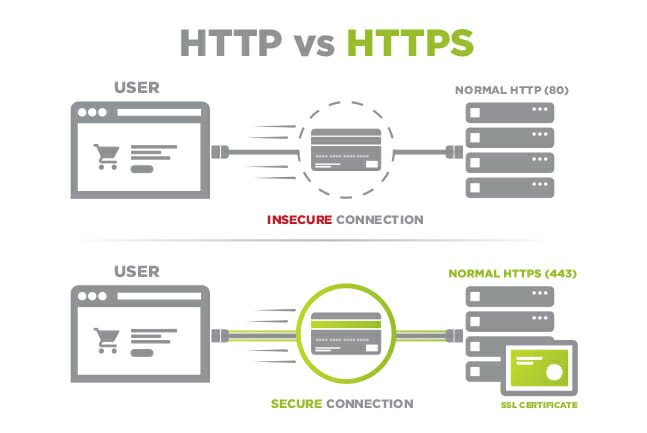
HTTPS is a best practice that will help your website boost its SEO presence, stay secure, and make it harder for malicious parties to break in and take advantage of your website.
Granted, transitioning to HTTPS is easier said than done, and requires a multi-step process.
When the Atlantic, a highly-regarded, well-established media organization, decided to move to HTTPS in early 2016, the transition was complex. First, content had to be scanned individually, then ported over and checked for compatibility. The process was repeated with ads, and once compatibility and security were ensured, the website slowly went live in order to guard against traffic loss and unforeseen errors.
If you’re a smaller organization, your process will likely be less painstaking or time consuming, but either way, moving to HTTPS is a necessity in a world of cybersecurity threats and heightened SEO and SEM requirements.
Follow this guide to make the switch on WordPress.
B) Enable AMP for Mobile
AMP, or Accelerated Mobile Pages, began as a Google-backed open initiative to allow publishers to easily create responsive, mobile-optimized content.
It takes information from website pages and displays them in an easy-to-view format for mobile devices:

Envisioned as a way to quickly render content on mobile devices like smartphones and tablets, AMP combines three components:
- HTML tags: which help common web patterns render quickly
- AMP JS: a library that manages the resource loading and best practices necessary for fast rendering
- AMP cache: a content delivery network that both loads content and ensures speed
Since AMP was only incorporated into the search giant’s results in February 2016, the format itself is still fairly new. For those of you who use WordPress, AMP should be much easier to implement than a home-grown CMS from scratch.
Want to implement AMP to help cater to mobile searchers? Here’s Google’s guide:
Learn More: Using Google AMP Pages to Boost Site Speed and Mobile Optimization
C) Budget Money for Crawlers
To make sure Google is crawling your preferred pages (and not pages that don’t appear in its index), you might need an extra pair of hands in the form of crawl software. We want to give search engines the best view of our website, right?
These SEO crawler programs are similar to Google’s own crawlers, and will give you an overview of how your page will perform when determining rankings for your target keywords:
- Deep Crawl: Possibly the most comprehensive tool of its kind available today, Deep Crawl is the equivalent of a physical exam for your website, checking its SEO health and viability in an increasingly crowded market. Deep Crawl will provide you with a laundry list of necessary improvements and errors, such as: duplicate content, broken pages, flawed titles, descriptions and metadata.
- Botify: A cloud-based crawler that has already signed up big names like Expedia and eBay, Botify is one of the strongest crawlers available today, short of Google’s own secret algorithms. Not only can Botify check whether Google has crawled your page, but it can also offer suggestions on how to restructure web content and site maps to optimize your web page for Google’s crawlers.
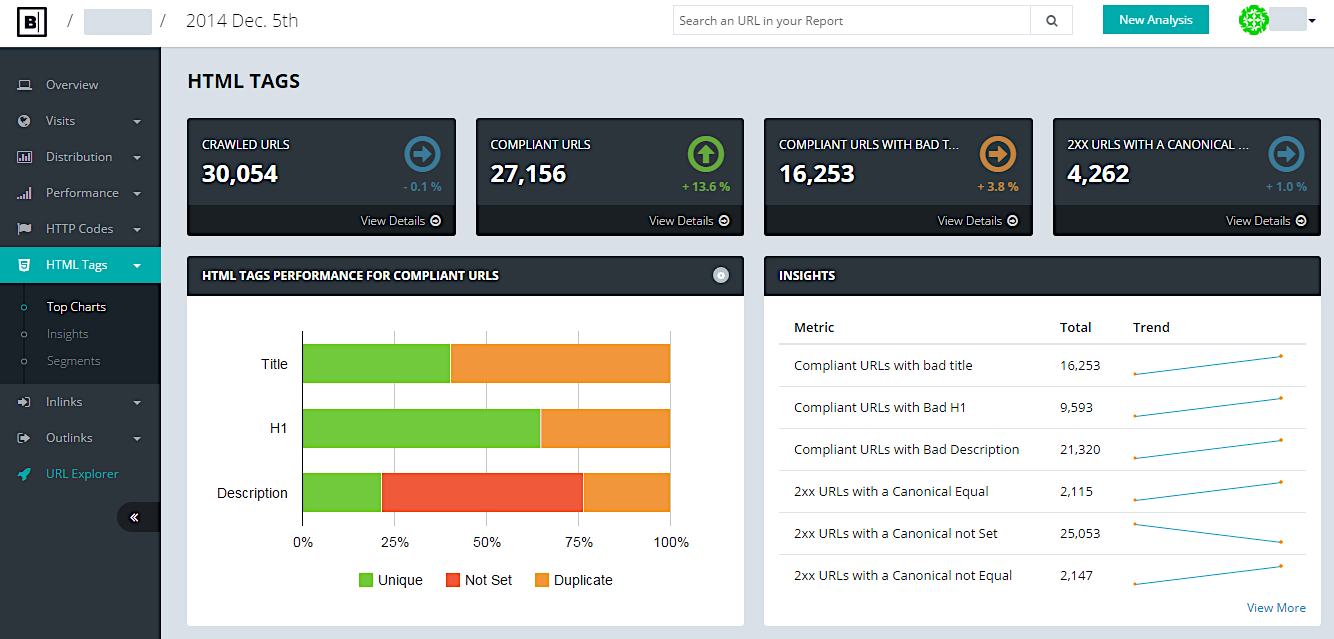
D) Correct Your Semantic Markups
To help Google understand your data, or to show your website smartcards and voice searches, you need to ensure that your semantic markups are correct.
Semantic markups are essentially HTML tags which can help emphasize key information on your website. It tells Google’s spiders what the page is about without needing to digest every word on the page.
Just take heading tags, for instance. Text wrapped in a <h1> tag is the page’s main title, and should give a brief explanation of the entire shared content on that page. Text wrapped in a <h2> tag are subheadings, and so on.
Here’s an example heading structure:
- <h1> The Ultimate Guide to Guest Posting
- <h2> What is guest posting?
- <h3> Benefits of guest blogging
- <h3> 5 types of links you can build
- <h2> How to write an awesome guest post
- <h3> 1. Pick the perfect website
- <h3> 2. Send an email pitch
- <h3> 3. Write your content
- <h2> What is guest posting?
Get the gist?
E) Fix “Page Not Found” 404 Errors by Redirecting URLs
Nothing will sink your website faster in search rankings than a 404 error.
Following a link that leads to a 404 page with the text “Error: Not Found” is essentially a dead end. And nobody likes being stuck in a dead end – especially your audience. So it’s in your interest to fix these broken or missing pages and re-engage your users as soon as you can.
First of all, download your backlink profile using a tool like Monitor Backlinks. Backlinks that are pointing to a pesky 404 error page will be highlighted, so sieve them out and head to your Google Analytics dashboard to find out how many page views the 404 error page gets.
You never know – you might find that you’re turning away 300 visitors each month because they’re arriving on your site with a dead end!
Keep those users around by using an SEO plugin like Redirection to redirect URLs of broken links to fully functioning pages. You’ll want to redirect the broken page to the next, most relevant page to make sure they’re not frustrated with landing on a totally different page than they expected.
Here’s an example:

Redirecting broken pages to new URLs will boost user experience, while also regaining any “link juice” from those pages. It’s a win-win for everyone involved!
Learn More: Data-Backed Best Practices for Building a Killer 404 Page
8) Target Local Searchers with Landing Pages and Listings
Almost half (46%) of all searches on Google are from people looking for local information. That could include:
- Local shops
- Opening hours
- Telephone numbers
- Addresses
So, if you have a brick-and-mortar business, you can’t neglect local SEO and listings if you want to stay profitable.
Here are three huge SEO techniques to capture local people who could become your customers. After all, 72% of people who search for local businesses online end up visiting stores within a five mile radius!
A) Double-Check Your Directory Listings
As powerful as search engines like Google or Bing are, they still can’t be everywhere at once, and have to rely on additional information from local, on-the-ground sources.
These sources can include directory listings, which gather, aggregate, and submit relevant data for area businesses – information from physical directories (like Yellow Pages) or scanning business registrations.
In a nutshell: Bigger search engines (like Google) will rely on these data aggregators to fill in the gaps of the existing information that’s already in their databases, and will also cross-check to make sure that the facts are up-to-date.
Problems arise, however, when aggregators collect out-of-date data, leading a search engine like Google or Bing to list the wrong information – such as an old address for your business or a disconnected phone number.
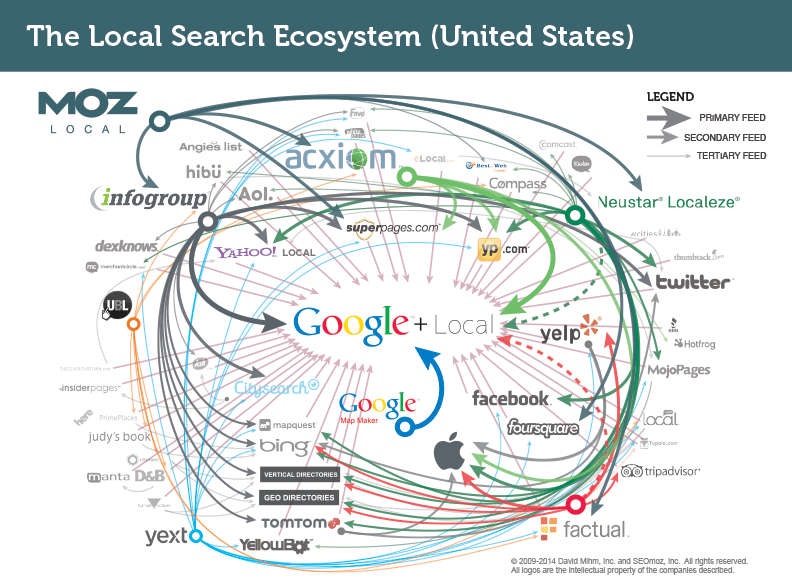
That’s why it’s critical to ensure that your physical contact information is as current as possible on every online listing you’ve created, including:
- Google My Business: Because Google is the largest search engine, start with Google My Business – a free-to-use listing service, and update your data accordingly. Be sure to list important details like extra locations, the latest opening hours, and what forms of payment are acceptable.
- Local Directory Management Service: This service carries out the painstaking, tedious work of scanning countless local directories, interacting with data aggregators, and correcting any old information. Moz Local and Yext both offer this service, which can help you avoid any glaring inconsistencies that can hurt your revenue strea – or even worse, trick Google’s algorithms into thinking that you’re a different business entirely. That’s not going to land any visitors to your store.
- Build more directory listings using Local Data Aggregators: Now that you’ve got the information down to a T, roll that out by using a local data aggregator like Bright Local. That way, you don’t need to painstakingly re-enter the same information over and over again, which is bound to lead to mistakes in itself!
From that point on, local search listings should be accurately and automatically updated by your management service. Oh, and remember to change all local listings if something changes – particularly when you move office or switch telephone numbers!
Learn More:
B) Build and Optimize Local Landing Pages
Let’s think about the search terms people use when they’re looking for local services. Chances are, they’re something like this:
- “SEO services in Los Angeles”
- “Best blow dry in Manchester, UK”
- “Where to buy candles in New York”
The only way to make sure you’re reaching the shortlist of Google’s SERPs is to actively target those keywords on your website – preferably with a local landing page. (A local landing page does what it says on the tin – targets people who are looking for something within a specific location.)
Just take a look at top organic results being shown for a local keyword:
Notice how they’re all local landing pages for the Finchley area, rather than a homepage or general “washing machine repair” service page?
Create your own (and start targeting local searchers who’re ready to visit your brick and mortar store) by:
- Doing keyword research to find local keywords relating to your product or service.
- Creating a new page on your website and optimizing it for those local keywords. That includes mentioning the phrase in: your meta title, meta description, page title, heading tags, image alt text, and on-site content.
- Building links from local directory listings to that page to strengthen location-based keyword rankings (e.g. If you’re creating a landing page for London, build links from London-based directories to the landing page’s URL).
C) Technical SEO for Local
Carrying out technical SEO for local search engines is a similar process to the one we discussed earlier. You may be questioning the point of optimizing for local search engines, especially given Google’s unquestioned dominance of the search landscape. Even so, local search engines are still extremely useful. Physical brick and mortar stores thrive on in-store visitors, right?
Here are some useful terms and techniques to ensure that you optimize your business for local searches:
First, understand that schema markup is one of the most powerful, least used parts of SEO today. Schema are basically brief snippets of data that can give extra information to search users and search engines. Best of all, schema markups don’t require extra coding, and can be inserted through Schema.org, a rare collaboration between Google, Yahoo, and Bing.
Schema is used on this listing, which gives local searchers extra information about the venue’s hours, location, general information, and more without actually visiting the page itself:
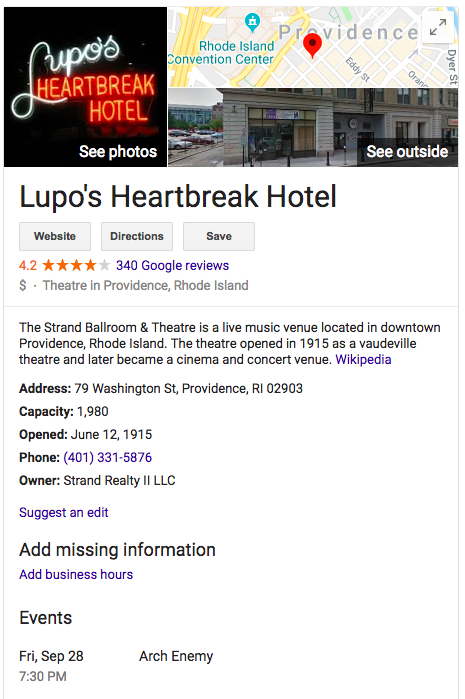
If you want to go a step further, you can also include a JSON (Javascript Object Notation) injection through Google Tag Manager. JSON is a form of data that is easily read by humans and artificial intelligences alike, and familiar to anyone who has ever used C++, Javascript, Python, etc.
With Google Tag Manager, however, it’s easy to combine schema and JSON together to further boost the strength of your schema, resulting in a higher CTR and visibility, without having to spend precious time and lines of code. Granted, the learning curve is a bit steep for those who aren’t familiar with Javascript or another basic programming language, but once set in place, JSON injections can help execute and put structured data in place simply and efficiently.
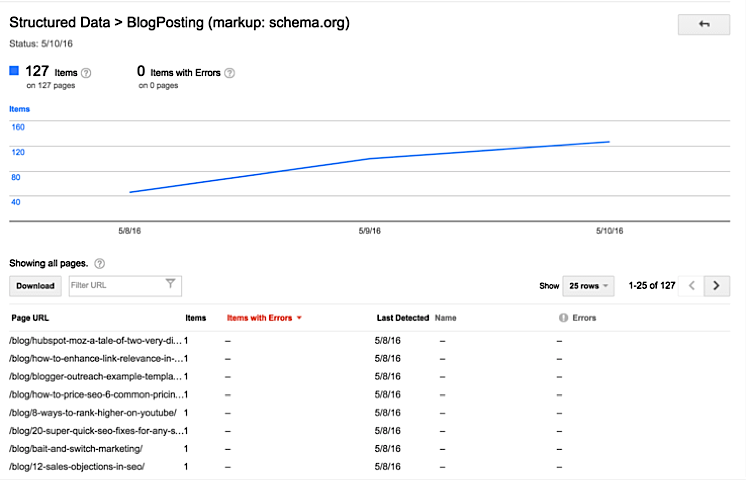
9) Know How to Measure SEO Performance
Reporting and analytics are two critical elements of SEO – both of which are indispensable to improving your overall marketing strategies.
Effective reporting means you can understand key questions such as:
- What content really appealed to your customer?
- What part of the website had the most UX issues?
- Which page was the least (or most) visited, and why?
- Which on-page SEO changes resulted in the highest rankings?
- Which style of keyword should you focus on, in future?
It’s tricky to understand those intricacies (and use them to your advantage to skyrocket your SEO even further) without regularly monitoring and reporting your results.
Here are three tools you can use to conquer exactly that:
A) Data Studio
Interested in gaining the ability to tie online data back to offline data in order to get a full 360 view of how your content and marketing is performing?
Google’s Data Studio helps you to do that by aggregating data (such as rankings, traffic, conversion data) from multiple sources into a single interface. It’s a fantastic SEO tool for internal teams to use, but also a superb way for SEO agencies to share fancy reports with their clients.
But, most importantly, the SEO metrics you’re able to track with Datastudio can help you determine the effectiveness of your SEO strategy, and assess whether you need to pivot or change tactics to improve on your results.

B) Wayback Machine
Always be on the lookout to see what your competitors are doing and how well it’s working for them. What techniques are they using? How have they changed their approach? What mistakes have they learned from?
One great tool to see how your competition has changed is Wayback Machine, which allows marketers to access petabytes of archived web pages. By sifting through Wayback Machine’s extensive database, you can track the evolution of your competitor’s brand and web presence – taking note of factors such as:
- Changes in UX design
- Differences in copy from one web version to the next
- Movements of key page elements, such as page navigation or calls to action
Still, you shouldn’t implement something just because your competitor is doing it – whether that’s designing a website a certain way or using specific copy or images. You’ve got to use your common sense, combined with industry knowledge, before giving your SEO team the go-ahead to copy their changes.
If used correctly, however, Wayback Machine has some interesting lessons to offer. Take a look at these two screenshots of Title Boxing: The top picture is a screengrab of their homepage from Wayback Machine, circa 2007, while the bottom one is a screengrab from 2018:
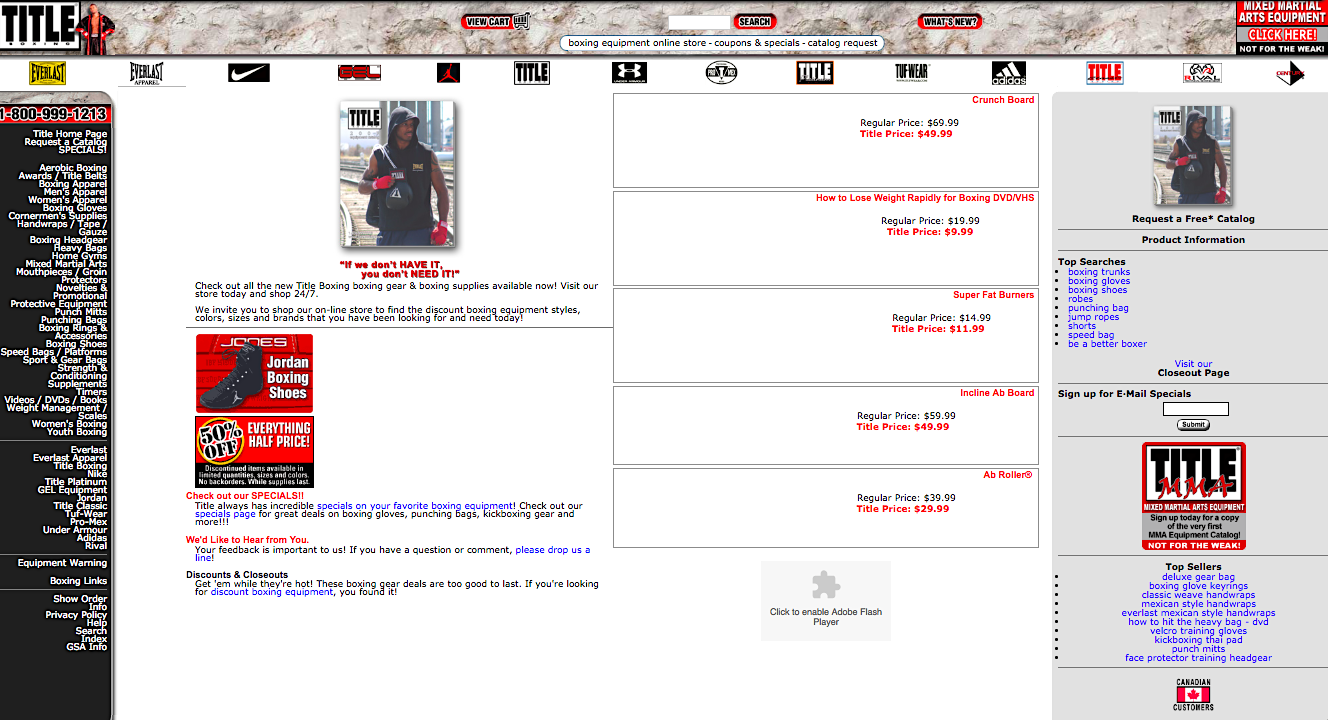
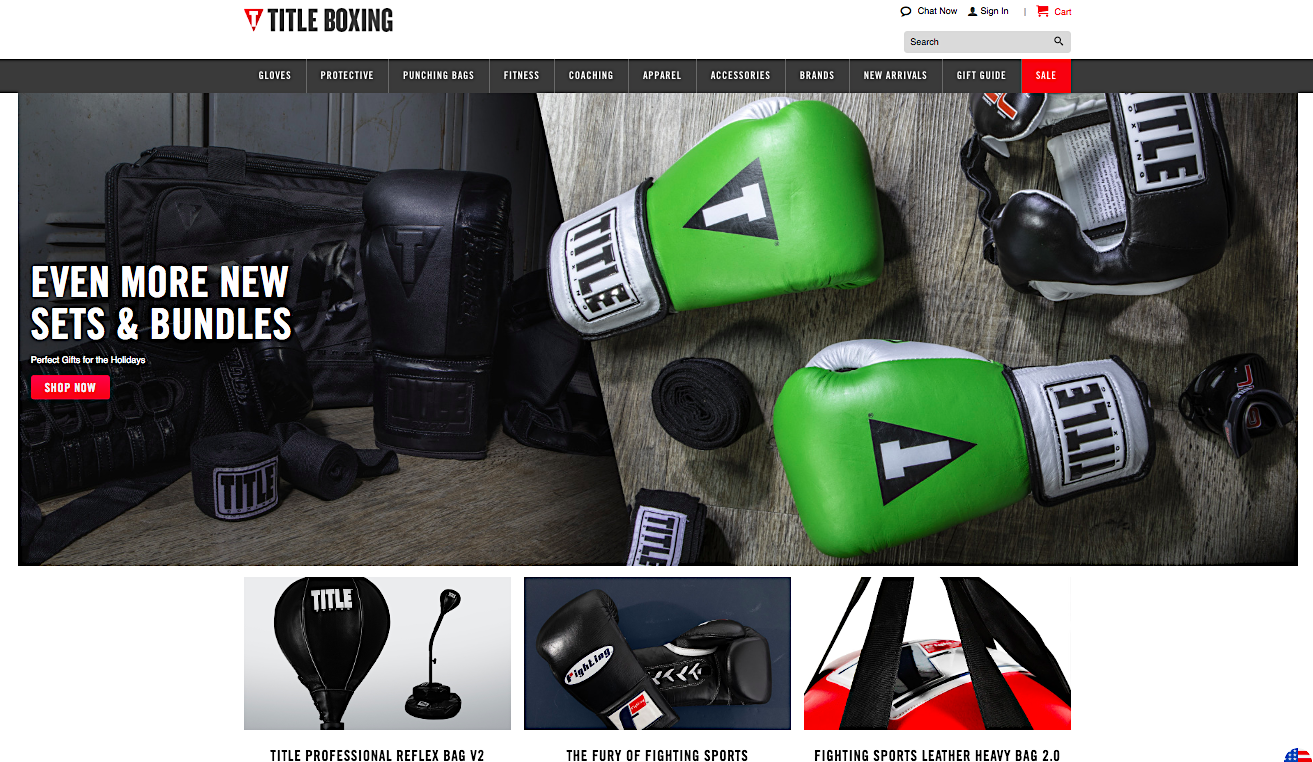
The differences are pretty clear. In 2007, the web layout was much more cluttered and crowded, with small, hard-to-navigate sidebars squeezing some small, insignificant-looking pictures in the middle advertising daily specials.
In 2018, however, the user experience is much more streamlined. Visitors are greeted with a clear, easy-to-use sidebar at the top, labeled with categories like “Gloves” and “Punching Bags.” A large, sliding image in the center replaces the tiny, hard-to-notice ads from 2007, allowing buyers to see exactly what is on sale.
In a nutshell: The new website is almost minimalist, doing away with the previous confused, slightly chaotic format. That might be a change you’ll want to think about implementing, too.
C) SEMrush
If you’ve followed this guide to a T, you might notice an influx of organic traffic arriving at your website from Google. That’s great news, but how can you find out which keywords are driving the most results?
Enter: SEMrush, an SEO tool used by marketers to track ever-changing keyword ranking positions in various search engines:
Keeping Up With SEO in 2019
SEO is rapidly changing from one year to the next, with new algorithms constantly emerging and Google frequently editing their webmaster guidelines. Business owners and marketers have to adapt quickly, but it’s still possible to give your business website the edge on your competition.
Remember to focus on solid content creation and copywriting fundamentals, engage your viewers deeply, and stay abreast of technical trends like backlinks, SEO health, site speed, and schema. And don’t be afraid of using a handful of the AI-based tools we’ve recommended to welcome the emerging AI revolution that’s set to take over the marketing world in 2019.
If all this seems overwhelming—take a deep breath. Making the effort to understand even the basics of SEO will help your website gain higher click-through rates, engagement, and of course, rankings.
But if you need more personalized, specific advice on how you can start ranking for competitive terms in your niche, become recognized as a thought leader in your industry, and make more money through organic search traffic, click the orange button below to schedule a time to chat!

